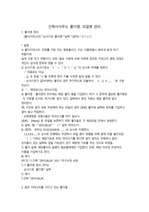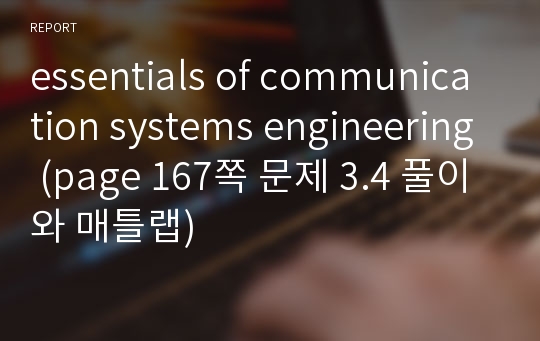essentials of communication systems engineering (page 167쪽 문제 3.4 풀이와 매틀랩)
*태*
다운로드
장바구니
소개글
essentials of communication systems engineering (john G. Proakis masoud salehi)page 167쪽 문제 3.4 풀이와 이에대한 매틀랩 구현. 그리고 자세한 분석.
목차
problem 3.4 Demodulation of the DSB-AM SignalThe message signal m(t), which is given in Problem CP-3.1 ( m(t) = sinc(100t), 0≤t≤to ), modulates the carrier c(t) = cos2πfct and results in the DSB-AM signal u(t) = m(t)c(t).
The carrier frequency fc = 250Hz and to = 0.1.
1. By selecting the sampling interval ts = 0.0001, generate 1000 samples of the message signal m(t), the modulated signal u(t), and plot both signals.
2. Demodulate the sampled DSB-AM signal u(t) generated in Part 1 by using the demodulator shown in Figure CP-3.4. Perform the demodulation for Φ = 0, π/8, π/4, π/2, and plot the received message signal mr(t). The lowpass filter is a linear-phase-FIR filter having 31 taps, a cutoff frequency (-3dB) of 100Hz, and a stopband attenuation of at least 30dB.
3. Comment on the results obtained in Part 2.
4. Instead of using a time-domain-lowpass filter to reject the frequency components centered at 2fc, compute the discrete-Fourier transform(DFT) of 1000 samples of the mixer output, set to zero those frequency components centered at 2fc and compute the inverse DFT to obtain the time-domain signal. Compare the results of this frequency-domain filtering with the time-domain filtering in Part 2.
- page 167쪽 문제 3.4 풀이
- 매틀랩 소스와 구현 그래프. 그리고 분석
본문내용
t=0:0.0001:0.1; % t sampled with sampling interval 0.0001fc=250; % carrier frequnecy
mt=sinc(100*t); % sampled message signal
ct=cos(2*pi*fc*t); % sampled carrier signal
ut=mt.*ct; % sampled DSB-AM signal
stem(t,mt,`b`); % ploting the sampled message signal using stem version
hold on
stem(t,ut,`r`); % ploting the sampled DSB-AM signal using stem version
▶ 어느 임의의 부분을 확대 하여서 보았다. stem 함수를 이용하였기 때문에 확대하여서 보면 확실하게 m(t)하고 u(t)가sampling 되었다는 것을 알 수가 있다.
2.
① ø=0
t=0:0.0001:0.1; % t sampled with sampling interval 0.0001
fc=250; % carrier frequnecy
mt=sinc(100*t); % sampled message signal
ct=cos(2*pi*fc*t); % sampled carrier signal
ut=mt.*ct;
phi=0; % sampled DSB-AM signal
mt1=ut.*cos(2*pi*fc*t+phi); % mixed signal when the phase is 0
h=fir1(30,0.2); % impulse response of LPF with 31 taps and 100Hz frequency response



























